Natural Indigo Dyeing Experience: Learning about Slow Fashion and Sustainability in Awaji Island

Awaji Island, a popular resort area, has many attractive spots, including restaurants and scenic spots. However, in addition to sightseeing, we would like to introduce "AiAii", an indigo dyeing experience spot that we would like to recommend to those who want to interact with local people and experience something unique to the area, especially something related to the SDGs, along with an interview with the shop owner.
-
Table of Contents
- Indigo Dyeing Experience Studio/Shop, AiAii
- The Interview with Sally Hancox: The Charm of Indigo Dyeing
- Indigo production process on Awaji Island
- Hancock's passion for indigo dyeing and what he wants to convey to customers through the experience
- Actual natural indigo dyeing experience
- Overview of Awaji Island's Natural Indigo Dyeing Experience Studio AiAii
- Indigo dyeing experience fee
- Recommended spots and access to Awaji Island
Indigo Dyeing Experience Studio/Shop, AiAii

Ai Aii Natural Indigo Dyeing Experience Studio is not only a studio where you can experience indigo dyeing, but also has a shop selling products designed and dyed by AiAii's owner, Sally Hancox. At the studio, you can experience indigo dyeing with dye liquid made by adding lye to "sukumo", a fermented indigo leaf that is either home-grown or from Tokushima Prefecture, a famous indigo leaf producing area, and fermenting it. All the products in the shop are hand-dyed, so they are one-of-a-kind and original, and they also accept orders for other items such as curtains and original T-shirts.
The Interview with Sally Hancox: The Charm of Indigo Dyeing
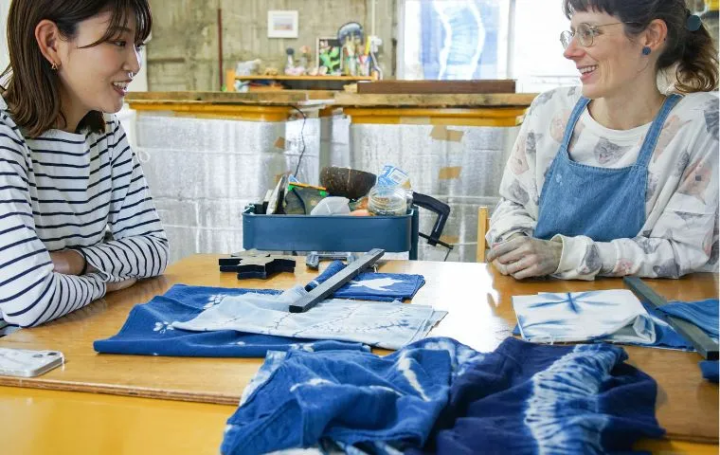
Sally Hancox started indigo dyeing when she moved to Awaji Island with her family about seven years ago. She originally loved making things and started making patchwork curtains. When she first started out, she used chemical dyes, but she became interested in natural dyes and pursued environmentally friendly methods through trial and error. She now owns her own farm and produces the "tadeai" dye, with about 60% of the dye she uses being grown on her own farm and the remaining 40% being sourced from Tokushima Prefecture, a famous indigo producing area. You can feel Ms. Hancox's commitment and strong feelings towards natural materials.
Indigo production process on Awaji Island
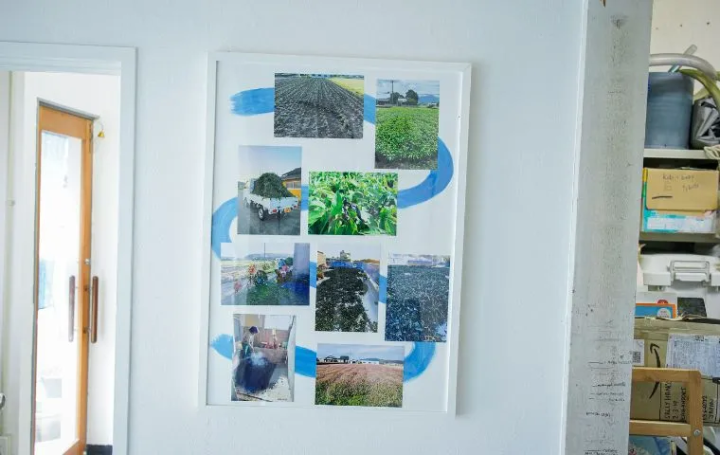
The process of producing "Tadeai" and turning it into dye is as shown on the poster on the wall. Seeds are sown from March to June, seedlings are raised, and the plants are planted in the fields. They are harvested from July to September, and the leaves and stems are separated. The leaves are blown away by a fan, and the stems are used as compost to feed the fields. The leaves are dried in the sun for one to two days to become the source of the dye. The dried leaves are stored in bags from October to December, and seeds are harvested for the next year. The indigo leaves are carefully fermented for 100 days to become the indigo dye "sukumo". After dyeing, the "sukumo" becomes fertilizer for the fields and returns to the soil. In this way, the production process is circulated without anything being wasted or thrown away. This is the charm of natural indigo dyeing, and it shows how hard it is for the producers.
Hancock's passion for indigo dyeing and what he wants to convey to customers through the experience
Ms.Hancox is particular about creating unique products through daily trial and error. They also want to provide customers with an opportunity to reconsider sustainable thinking through the natural indigo dyeing experience, and to create an opportunity for people to try incorporating slow fashion, rather than fast fashion, into their daily lives, ultimately leading to environmental conservation and a sustainable society. As the writer of this article, I was able to become attached to the indigo-dyed products I made and realized that one way to enjoy them is to dye them again and reuse them.
Actual natural indigo dyeing experience
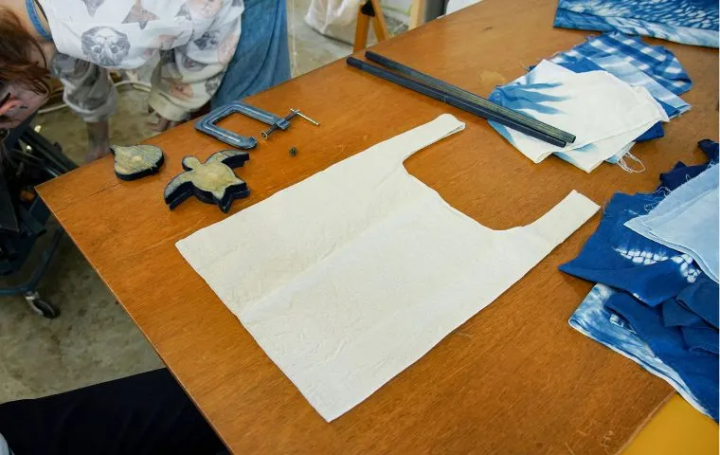
This time, I tried making an eco-bag. Ms. Hancock will teach you step by step about what kind of pattern you want and what techniques you should use to achieve the pattern you want. When you start indigo dyeing, gloves and aprons are available for rental, but we recommend that you wear clothes that you don't mind getting dirty.

Once the indigo dyeing is ready, the process of dyeing the fabric can begin. The color intensity of natural dyes changes daily depending on the temperature and conditions, so temperature control is also important. The temperature should be such that you can feel a slight warmth when you put your hand into the dye. As it is a natural product, it is safe to dye with bare hands, so even small children can safely experience indigo dyeing.
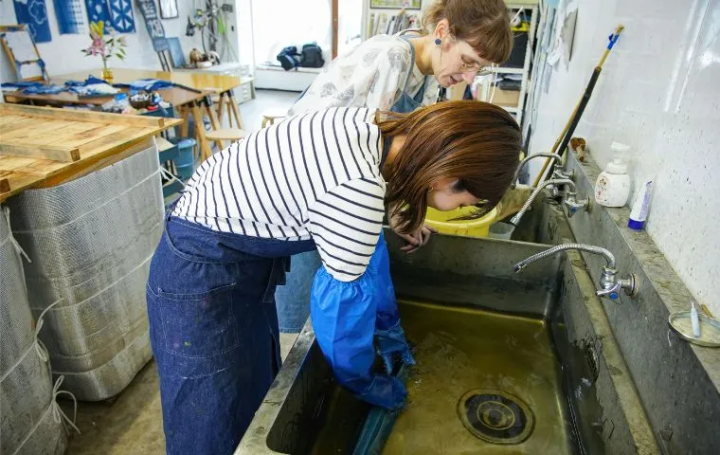
The process involves dipping the fabric in the dye and rinsing it with water. While checking the condition of the dye and how well it has absorbed, this process is repeated until you get the color you like. The joy of making something by hand is that you may dye it a little, not dye it, or dye it too much. In the case of this eco bag, it took about an hour and a half to make. Another great thing about this experience was that you could take it home right after you made it.

Here is the finished eco bag. This time, we tried a checkered pattern. We dyed it a little darker so that it would last a long time and we could enjoy the fading of the color. Ms. Hancox carefully taught us during the experience, and we had fun conversations, so the time flew by. We recommend that you try this indigo dyeing experience, which can be enjoyed by children and adults alike! We highly recommend it for those who want to enjoy making things with friends, loved ones, and family.
Overview of Awaji Island's Natural Indigo Dyeing Experience Studio AiAii
Address: 2-2-19 Kaigandori, Sumoto City, Hyogo Prefecture, 656-0022
TEL0799-20-5252
Business hours: 10:00~17:00 (Shop: Fridays and Saturdays only / Indigo dyeing experience: Closed on Sundays)
Indigo dyeing experience fee
Handkerchief: 1,200 yen
Hand towel: 2,000 yen
Linen stole: 5,000 yen
Eco bag: 4,000 yen
Organic cotton T-shirt (S, M, L, XL): 7,800 yen
*Advance reservations are required via phone, Instagram or website.
Recommended spots and access to Awaji Island
If you are planning to go to Awaji Island and would like to visit other spots and enjoy the local cuisine, please refer to the link below. We will introduce the top 15 must-see spots on Awaji Island.
Awaji Island is a popular resort area in the Kansai region, about 30 minutes by car from Kobe and about an hour from Osaka. Even if you don't have a car, you can easily get there by bus from Kobe Sannomiya or Shin-Kobe Station on the Shinkansen Line. For more information, please see below.
Awaji Island, located in the Seto Inland Sea in Hyogo Prefecture, is known for its rich history, delicious food, and beautiful nature. Just one hour from Osaka, it offers a perfect escape from the busy cities of the Kansai Region. We are here to introduce you to the beautiful spots on Awaji Island, including hotels, restaurants, events, theme parks, and much more. This account is operated mainly as a PR effort by Pasona Group.
The contents on this page may partially contain automatic translation.































![[JR KYUSHU HOTEL Blossom Oita] A hotel directly connected to Oita Station - A comprehensive guide to access!](https://resources.matcha-jp.com/resize/720x2000/2025/10/23-247814.webp)
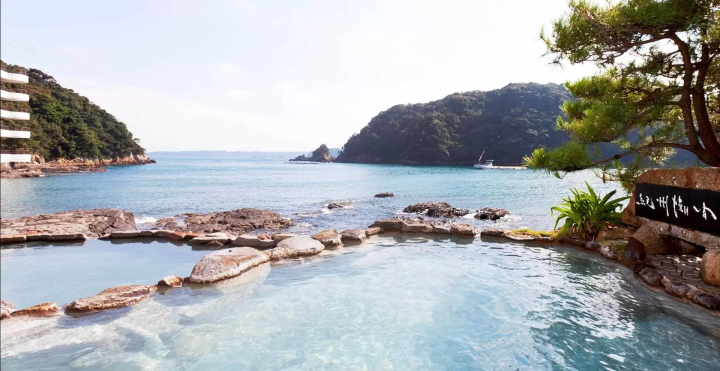
![Deep dive into Japanese brands! A tour of famous leather shoe stores with GENSEI & Nin [Harta Edition]](https://resources.matcha-jp.com/resize/720x2000/2025/12/18-253277.webp)
